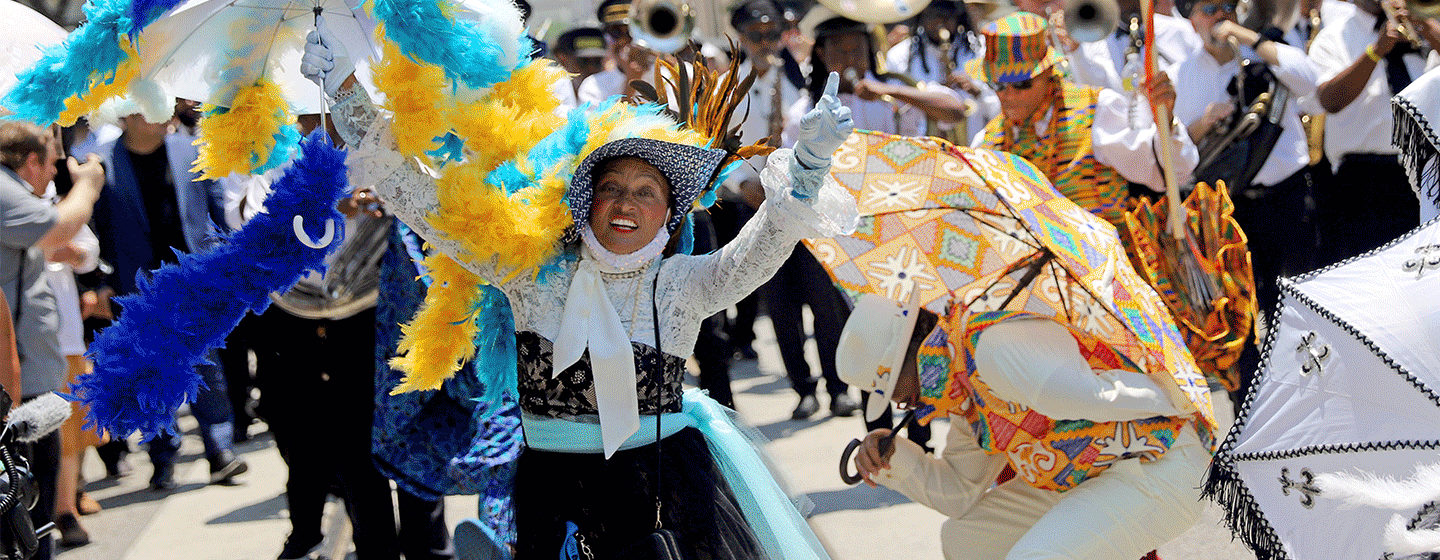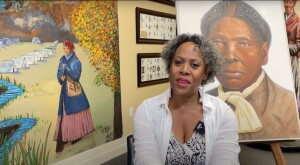The first enslaved Africans arrived in New Orleans in 1719, one year after the city’s founding. In the next 300-plus years, Black peoples’ impact on the city has helped N’awlins become one of the world’s most culturally diverse and exciting places to explore.
“Every aspect of culture in New Orleans is tied to the Black experience,” says Bradley Sumrall, a curator at the city’s Ogden Museum of Southern Art in the Warehouse Arts District, just outside the French Quarter. “The food for which we’re so famous was heavily influenced by African traditions, American music was born here and its architects were almost exclusively Black. Dance, theater, literature and the visual arts are all deeply informed by the Black experience in New Orleans.”
Visit the Ogden — a 47,000-square-foot, five-story facility — in this fantastic city, and treat yourself to one of the country’s finest collections of work by Black artists across all media.
Every aspect of culture in New Orleans is tied to the Black experience. The food for which we’re so famous was heavily influenced by African traditions, American music was born here and its architects were almost exclusively Black. Dance, theater, literature and the visual arts are all deeply informed by the Black experience in New Orleans.
Showcasing Black artists through its acquisitions and exhibitions has been a specialty of the Ogden since its opening in 2003. Legendary painter Benny Andrews even served as the first artist member of its board of trustees. “Not only was he a huge voice in American art, but he was an advocate who championed the inclusion of women and artists of color in museum collections,” Sumrall says. “He brought those concepts into the very conceptual planning of the Ogden and its mission.”Depicting life in the rural South
The Ogden now holds the largest public collection of Andrews’ work — 242 drawings, watercolors and oil paintings — many of which you can see in a gallery dedicated to this essential artist and activist, who died in 2006. In his best known and most powerful works, Andrews brilliantly delivers figurative paintings of folks living in the rural South, the very life he himself lived, having been born in Plainville, Georgia, in 1930. Through his skillful brushwork, he shares their burdens, their hunger, their toil, their concerns. He doesn’t just invite viewers into the scenes, he invites them into his subjects’ souls.
One standout: his 1965 Death of the Crow. Although the 1964 Civil Rights Act ended the Jim Crow era of legal segregation around the nation, the figure in Andrews’ painting seems skeptical. The “crow,” with outstretched talons and a pointy beak, may have fight in it yet — and history would prove the artist’s expression correct.Plan Your Trip
Location: 925 Camp Street, New Orleans
Visit: Open daily, 10 a.m. to 5 p.m. (closed Mardi Gras Day, Thanksgiving, Christmas and New Year’s Day)
Admission: $13.50 ($11 for adults 65 and older); purchase timed tickets online
Getting there: The museum is about 20 minutes from the airport.
Also consider weather: Summer visitors can expect to sweat, making this air-conditioned venue a great choice to escape the heat of the day.
Accessibility: Fully accessible, with all levels reachable by elevator.The stunning work of self-taught artists like Clementine Hunter
Discover additional talent as you wander through the Ogden’s other galleries. Much of what you’ll see falls into the category of vernacular art, meaning the work of self-taught artists. Their work provides plainspoken insight into the 20th century Black experience throughout the South.
Besides Andrews’ work, Sumrall recommends you not miss that of another artist featured in the museum. “I can’t imagine the Ogden Museum without the constant presence of Clementine Hunter,” he says.
Born in Louisiana in late 1886 or early 1887, Hunter lived for a century before her death in 1988. Her work is deeply evocative of the state and its values: connection to the land, family, cultural memory, faith, ritual, the value of a person’s labor. Whereas Andrews’ paintings have a broadly Southern perspective, Hunter’s incisively focus on Louisiana, taking you along its back roads and outside its churches. Long after you return home, the mere mention of her name will bring to mind vivid images of the state.
Her 1945 painting Panorama of Baptism on Cane River — painted on a window shade — exemplifies why she called her art “memory paintings.” It transports you to a baptism at St. Augustine Catholic Church on the Cane River, in Natchitoches Parish in central Louisiana. Parishioners dressed in their finest line the riverbank, the baptized are in the water, and a man rings a bell outside the church. It’s a scene Hunter surely witnessed numerous times.
Also seek out the paintings of Thornton Dial and Purvis Young, two other giants of 20th century vernacular art. Dial, an Alabama artist who died in 2016, was a master of mixed media. The expansive canvas Struggling Tiger in Hard Times — measuring 5 feet by almost 8 feet and incorporating oil, carpet, industrial sealing compound, rope and tin — thrashes and roars.
Unlike Hunter and Dial, Young didn’t live in a rural area, but rather in Miami, where he died in 2010. He energetically captures the city’s scene in Cityscape With Cars. Pay close attention to his frames, all of which he constructed himself with discarded materials given to him or that he found.Beyond paintings
There’s more to see at the Ogden than paintings. Its other galleries delight with colorful ceramics, fabric pieces, historic and contemporary photographs, metalwork, ordinary objects found around households and neighborhoods fashioned into art objects, sculpture, woodworking and more.Nearby
Le Musée de f.p.c.: This museum, in a Greek Revival house on picturesque Esplanade Avenue, honors the city’s long legacy of free people of color (f.p.c.): Black people born free or manumitted (released from slavery) before the Civil War. Roughly 18,000 lived in the city when the war began, one of the country’s largest and oldest such communities. The museum displays decorative arts, documents (including original manumission papers), paintings and photographs that “present, interpret and preserve the history” of this often-overlooked group. Due to COVID-19, the museum offers limited access. Call 504-323-5074 or visit its website for info and advance tickets.
New Orleans Museum of Art (NOMA): Clementine Hunter’s art is also at NOMA, the city’s oldest fine arts institution. NOMA began collecting her work in the 1950s and hosted her first museum show in 1955, one of the country’s first solo shows for a female African American artist. Open Tuesday to Sunday, 10 a.m. to 6 p.m.; closes at 5 p.m. on Saturday (though they have extended hours through mid-July 2022 for the “Queen Nefertari’s Egypt exhibit”; check their website for details); tickets are $15, $10 for adults 65 and older, and can be purchased online or in person.
Algiers Folk Art Zone & Blues Museum: For something less institutional and more personal, venture to this small museum in the city’s Algiers Point district on the West Bank. Founded by self-taught Black artist Charles Gillam in 2000, this eclectic find showcases art by various Black folk artists as well as blues music history, including hand-carved and painted portraits by Gillam of blues legends such as Louis Armstrong and Memphis Minnie. Fun facts: Gillam’s father played guitar for Fats Domino, and the Smithsonian’s National Museum of African American History and Culture in Washington, D.C., acquired Gillam’s depiction of Fats playing the piano on the roof of his flooded New Orleans studio in the aftermath of Hurricane Katrina. Due to COVID-19, visits are currently by appointment only: 504-261-6231.Where to dine
Locals count these two Black-owned hot spots among their favorite restaurants in a city famous for its dining scene.
Willie Mae’s Scotch House: The fried chicken draws crowds to this casual restaurant, a mainstay in the city for decades now run by the great-granddaughter of the original owner, Willie Mae Seaton. It won the James Beard Foundation America’s Classics Award in 2005, a coveted distinction given to restaurants that keep regional culinary traditions alive. Pick from two locations — one in the Tremé neighborhood between the French Quarter and NOMA, the other in the Pythian Market downtown.
Bywater American Bistro: Owner Nina Compton, winner of the 2018 James Beard Foundation Best Chef: South Award, serves up fine dining in a casual setting in the Bywater neighborhood, on the other side of the French Quarter from the Warehouse District. In-the-know locals come for the jerk chicken rice and the spaghetti pomodoro.
This article has been adapted from aarp.org. Click here for more information.










